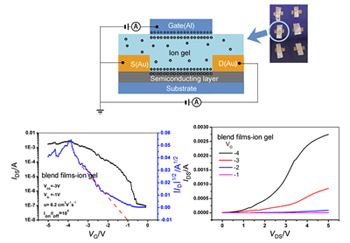| [1] Padinger, F.; Rittberger, R. S.; Sariciftci, N. S. Adv. Funct. Mater. 2003, 13, 85.
[2] Li, G.; Shrotriya, V.; Huang, J.; Yao, Y.; Moriarty, T.; Emery, K.; Yang, Y. Nat. Mater. 2005, 4, 864.
[3] Jin, K. Y.; Lee, K.; Coates, N. E.; Daniel, M.; Nguyen, T.; Mark, D.; Heeger, A. J. Science 2007, 317, 222.
[4] He, M.; Han, W.; Ge, J.; Yu, W.; Yang, Y.; Qiu, F.; Lin, Z. Nanoscale 2011, 3, 3159.
[5] Pei, J.; Hao, Y.; Lü, H.; Sun, B.; Li, Y.; Wang, S. Acta Chim. Sinica 2014, 72(12), 1245. (裴娟, 郝彦忠, 吕海军, 孙宝, 李英品, 王尚鑫, 化学学报, 2014, 72(12), 1245.)
[6] Hao, Y.; Ma, J.; Sun, B.; Li, Y.; Ren, J. Acta Chim. Sinica 2010, 68(1), 33. (郝彦忠, 马洁霞, 孙宝, 李英品, 任聚杰, 化学学报, 2010, 68(1), 33.)
[7] Ohmori, Y.; Uchida, M.; Muro, K.; Yoshino, K. Jpn. Appl. Phys. 1991, 30, L1938.
[8] Ohmori, Y.; Uchida, M.; Muro, K.; Yoshino, K. Solid State Commun. 1991, 80, 605.
[9] Mcquade, D. T.; Pullen, A. E.; Swager, T. M. Chem. Rev. 2000, 100, 2537.
[10] Facchetti, A. Chem. Mater. 2011, 23, 733.
[11] Wang, C.; Dong, H.; Hu, W.; Liu, Y.; Zhu, D. Chem. Rev. 2012, 112, 2208.
[12] Zhao, G. J.; He, Y. J.; Peng, B. Chin. J. Chem. 2012, 30, 19.
[13] Scheinert, S.; Paasch, G.; Schrödner, M.; Roth, H. K.; Sensfuß, S.; Doll, T. J. Appl. Phys. 2002, 92, 330.
[14] Payerne, R.; Brun, M.; Rannou, P.; Baptist, R.; Grévin, B. Synth. Met. 2004, 146, 311.
[15] Tanaka, S.; Grévin, B.; Rannou, P.; Suzuki, H.; Mashiko, S. Thin Solid Films 2006, 499, 168.
[16] Sauvé, G.; Javier, A. E.; Zhang, R.; Liu, J.; Sydlik, S. A.; Kowalewski, T.; McCullough, R. D. J. Mater. Chem. 2010, 20, 3195.
[17] Babel, A.; Jenekhe, S. A. Synth. Met. 2005, 148, 169.
[18] Wang, G.; Swensen, J.; Moses, D.; Heeger, A. J. J. Appl. Phys. 2003, 93, 6137.
[19] Nagamatsu, S.; Takashima, W.; Kaneto, K.; Yoshida, Y.; Tanigaki, N.; Yase, K. Appl. Phys. Lett. 2004, 84, 4608.
[20] Yu, H. Z.; Peng, J. B. Acta Phys.-Chim. Sin. 2008, 24, 905. (於黄忠, 彭俊彪, 物理化学学报, 2008, 24, 905. )
[21] Motaung, D. E.; Malgas, G. F.; Nkosi, S. S.; Mhlongo, G. H.; Mwakikunga, B. W.; Malwela, T.; Arendse, C. J.; Muller, T. F. G.; Cummings, F. R. J. Mater. Sci. 2013, 48, 1763.
[22] Lu, G.; Tang, H.; Qu, Y.; Li, L.; Yang, X. Macromolecules 2007, 40, 6579.
[23] Babel, A.; Jenekhe, S. A. J. Phys. Chem. B 2003, 107, 1749.
[24] Zen, A.; Saphiannikova, M.; Neher, D.; Asawapirom, U.; Scherf, U. Chem. Mater. 2005, 17, 781.
[25] Jiu, T.; Reiss, P.; Guillerez, S.; Bettignies, R. D.; Bailly, S.; Chandezon, F. IEEE J. Sel. Top. Quant. 2010, 16, 1619.
[26] Kergoat, L.; Battaglini, N.; Miozzo, L.; Piro, B.; Pham, M. C.; Yassar, A.; Horowitz, G. Org. Electron. 2011, 12, 1253.
[27] Park, Y. D.; Lim, J. A.; Jang, Y.; Hwang, M.; Lee, H. S.; Lee, D. H.; Lee, H.; Baek, J.; Cho, K. Org. Electron. 2008, 9, 317.
[28] Tomioka, K.; Tanaka, T.; Hara, S.; Hiruma, K.; Fukui, T. IEEE J. Sel. Top. Quant. 2011, 17, 1112.
[29] Duan, X.; Niu, C.; Sahi, V.; Chen, J.; Parce, J. W.; Empedocles, S.; Goldman, J. L. Nature 2003, 425, 274.
[30] Chang, S.; Chuang, V. P.; Boles, S. T.; Ross, C. A.; Thompson, C. V. Adv. Funct. Mater. 2009, 19, 2495.
[31] Chen, Y. W.; Jiang, S. H.; Shao, B. X.; Wang, R. C. Chin. J. Inorg. Chem. 2007, 23, 915. (陈扬文, 江素华, 邵丙铣, 汪荣昌, 无机化学学报, 2007, 23, 915.)
[32] Yang, J. Y.; Lu, S. G.; Ding, H. Y.; Zhang, X. Y.; Kan, S. R. Chinese J. Inorg. Chem. 2010, 26, 1837. (杨娟玉, 卢世刚, 丁海洋, 张向军, 阚素荣, 无机化学学报, 2010, 26, 1837.)
[33] Srivastava, S. K.; Kumar, D.; Schmitt, S. W.; Sood, K. N.; Christiansen, S. H.; Singh, P. K. Nanotechnology 2014, 25, 175601.
[34] Peng, K.; Fang, H.; Hu, J.; Wu, Y.; Zhu, J.; Yan, Y.; Lee, S. Chem. Eur. J. 2006, 12, 7942.
[35] Liao, L.; Bai, J.; Lin, Y. C.; Qu, Y.; Huang, Y.; Duan, X. Adv. Mater. 2010, 22, 1941.
[36] Lei, T.; Dou, J.; Cao, X.; Wang, J.; Pei, J. Adv. Mater. 2013, 25, 6589.
[37] Fu, X. L.; Wang, C. L.; Li, R. J.; Dong, H. L.; Hu, W. P. Sci. China Chem. 2010, 6, 1225.
[38] Lin, J.; Zhong, J.; Zhong, S.; Li, H.; Zhang, H.; Chen, W. Appl. Phys. Lett. 2013, 103, 63109.
[39] Tarabella, G.; Mahvash Mohammadi, F.; Coppedè, N.; Barbero, F.; Iannotta, S.; Santato, C.; Cicoira, F. Chem. Sci. 2013, 4, 1395.
[40] Huang, J. K.; Jiang, P.; Hsu, C. L.; Chiu, M. H.; Juang, Z. Y.; Chang, Y. H.; Chang, W. H.; Iwasa, Y.; Takenobu, T.; Li, L. J. ACS Nano 2014, 8, 923.
[41] Yuan, H.; Shimotani, H.; Ye, J.; Yoon, S.; Aliah, H.; Tsukazaki, A.; Kawasaki, M.; Iwasa, Y. J. Am. Chem. Soc. 2010, 132, 18402.
[42] Zhang, J.; Han, Z.; Chen, M.; Yang, X.; Cao, W. J. Phys. Chem. Solids 2010, 71, 1316.
[43] Srivastava, S. K.; Kumar, D.; Schmitt, S. W.; Sood, K. N.; Christiansen, S. H.; Singh, P. K. Nanotechnology 2014, 25, 175601.
[44] Huang, J.; Pu, J.; Hsu, C.; Chiu, M.; Juang, Z.; Chang, Y.; Chang, W.; Iwasa, Y.; Takenobu, T.; Li, L. ACS Nano 2014, 8, 923. |
